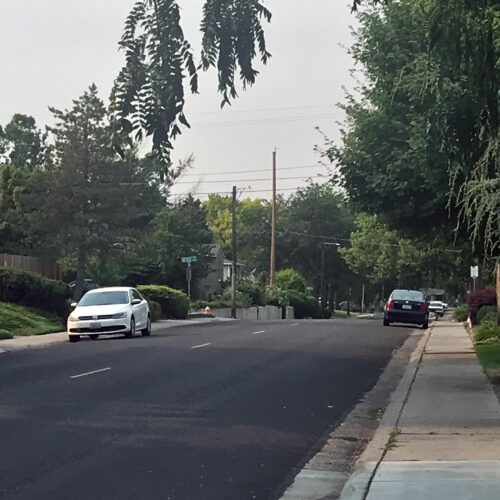
David Govedare, Artist Behind Wild Horse Monument, Iconic Metal Work, Dies
Listen
David Govedare, the artist behind the iconic Bloomsday runner statues in Spokane’s Riverfront Park and the Wild Horse Memorial in central Washington, died just before Thanksgiving.
In his life, Govedare produced hundreds of metal sculptures. His pieces adorn buildings, parks and landscapes across the Northwest.
Govedare’s long-time friend, musician Cary Fly, says the artist came up with ideas for sculptures and designs quickly, but he also thought about a piece’s long-term value, and how they might look in decades, or after hundreds of years.

CREDIT: Spokane Arts
“For one long period, 20 years or so, he was making everything out of steel and iron that would rust,” Fly said. “Kind of like the runners in the park. He would go, these things have a lifespan of over 500 years. He goes, by then, they’re going to look really cool, as they rust away. And he wanted them to rust away, this was the kind of guy he was, because, he goes, that’s what we do, we get born, and then we grow, and we kind of rust away.”
Fly says Govedare was well known among and worked with musicians and artists. In addition to creating personal pieces for his friends, he also designed album covers, including Fly’s seven albums.
Govedare’s pieces are almost all metal work. They often portray people in nature, animals and the stars. He often drew inspiration from Native American cultural themes.
Govedare’s best known in Washington for “Grandfather Cuts Loose the Ponies,” a sculpture of 15 horses atop a bluff overlooking the Columbia River and I-90 in Grant County.
Karen Mobley, an artist who previously administered public art projects for the city of Spokane, says the horses are an example of the energy and the style that run through most of Govedare’s pieces.
“I think that piece at Vantage is very successful because it gives you the sense that there’s something really happening up there on the hill,” Mobley said. “It works up close, but it also works from quite a distance. It’s a thing that almost everyone that drives back and forth to Seattle looks up there to make sure it’s still there because it’s so impressive and it has such a strong presence there.”
Govedare had been working to finish the sculpture since it was erected more than 30 years ago. His original design included a large metal basket the horses were running out of, but Govedare never had the funds to build it.
 Over the years, he did manage to make other improvements. With the assistance of friends, Govedare carved a trail up the hillside to make the piece more accessible.
Over the years, he did manage to make other improvements. With the assistance of friends, Govedare carved a trail up the hillside to make the piece more accessible.
In a 2018 interview with longtime friend Don Hamilton, Govedare said whatever the sculpture’s future, it was important to him to preserve its wildness.
“The sculpture itself is eminently wild like the wild grasses and the sage, the basaltic rock and the river,” Govedare said. “Everything here is pristinely left alone and wild. This sculpture in its completion and in its generational time it’s going to be over the generation’s needs to keep that look to it. It has to keep that look. Anything we do to make it better for viewers as far as their experience, needs to be done with the consideration of keeping the site primitive. Because if people pull up here and they saw a gift store, bathrooms and guard railings, and all kinds of things, then the piece would instantly lose much of what it says about wild horses.”
Govedare grew up in California and moved to Spokane in the early 1970s.
His other well-known pieces include “The Joy of Running Together” in Riverfront Park, a public art piece he crafted in honor of Bloomsday, and the Eagle and Osprey feather sculptures that stand near downtown Coeur d’Alene.
Govedare also built many smaller pieces for public buildings around Washington, including schools in Spokane, Spokane County and Colville.
David Govedare leaves behind one son, Forest, who he mentored in metal work. Govedare was 71.
Govedare’s friends are hoping to preserve his workshop and home in Chewelah, and they are working to raise money to build the metal basket that would finish “Grandfather Sets Loose the Ponies” in his honor.
Editor’s Note: The audio featuring the voice of David Govedare is courtesy of Don Hamilton and was an interview that was part of a series of interviews Govedare participated in before his death in hopes of completing “Grandfather Cuts Loose the Ponies.”
Copyright 2021 Spokane Public Radio. To see more, visit spokanepublicradio.org
Related Stories:

Oral history project recounts queer resilience in Walla Walla Valley
A crowd studies the exhibit “Sweeter Than the Onions: Stories of Queer Resilience in Walla Walla,” at Whitman College. (Credit: Courtney Flatt, Northwest News Network) Listen (Runtime 3:13) Read The

Art exhibit showcases the beauty of the mighty Columbia
Hat Rock, 2022, acrylic on panel, by Erik Sandgren (American, b. 1952) is on display at the Maryhill Museum until Nov. 15. (Courtesy: Maryhill Museum) Listen (Runtime 0:56) Read The

Art is a tool for enhancing mental health in Yakima
In Yakima, some organizations use art to promote mental health. After-school activities and events help people to explore self-expression and creativity to improve their emotional and social well-being.
















